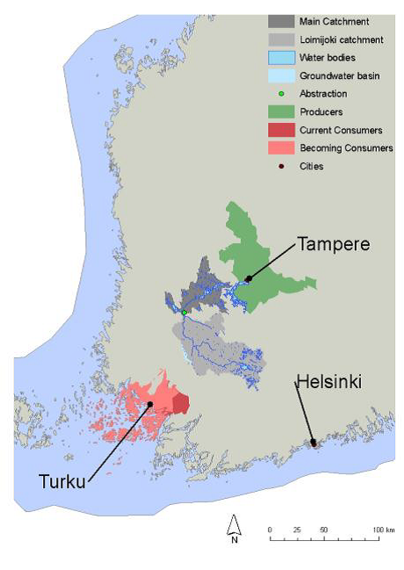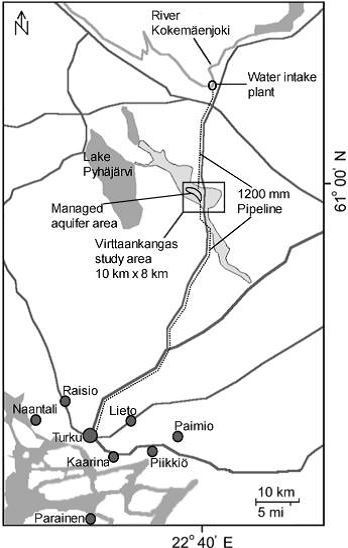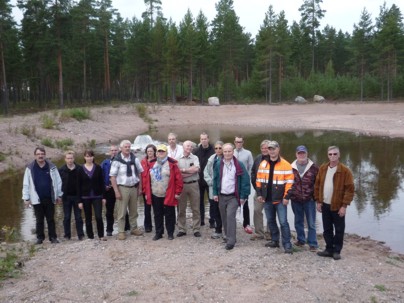Shortcut: http://www.syke.fi/projects/conpat
Background
Freshwaters are important sources of life in innumerable ways. We need freshwaters for fishing, irrigation, production of several industrial items, sanitation and refreshment. Ecosystem services connected to freshwaters include hydropower and food production, recreation and drinking water supply. An essential service is the provision of drinking water of groundwater and surface water resources.
Despite the highly developed waste water treatment and the process of drinking water production, several factors may threaten water safety in Finland. Harmful contaminants such as microbes and chemicals of diverse sources are no always sufficiently removed or disinfected and may be transported from water resource to consumer water.
The number one principle in water safety is the protection of the source water. However, this is very challenging nowadays since the diversity of contaminants varies from large number of pharmaceutical chemicals to pathogenic microbes and agriculture based nutrients. The same water resource is often a recipient of municipal and industrial waste waters, and release of nutrients from agriculture and settlement in the catchment area. The phenomenon being multidimensional, there is a need for holistic, system-wide approach to water safety.
The 4-year Conpat research project funded by the Academy of Finland establishes interdisciplinary methods for working with problems connected to water contamination. First aspect of the study is the behavior and fate of pathogenic microbes and chemicals and their transport in a water course. What are the concentrations of certain harmful contaminants in recipient waters of sewage treatment plant? How are they transported downstream and finally to a consumer's tap? Central methods are chemical and microbiological analysis of water samples and application of mathematical models for the transport of substitutes in a water course. The experimental work takes place in Kokemäenjoki water course downstream from Tammerkoski river rapids, where the water flows through Lake Pyhäjärvi in Tampere and downstream into River Kokemäenjoki in Nokia.

|

|
| The research area consisting of the Kokemäenjoki downstream from Tampere and the artificial groundwater recharge area of Virttaankangas Esker. |
The second task is to assess the effects of substitutes on human health and predict their economical impacts on society. In Finland, most of the water-based epidemics are caused by groundwater resources polluted by microbes, but in some cases, the epidemics has derived from the usage of unpurified lake or river water as drinking water. The most common pathogens found so far, are norovirus and camylobacteria which cause diarrhea disease. Preventing the transport of pathogenic and harmful contaminants in consumer water efficiently and considerably, significant savings in mitigation costs can be attained.
Finally, the risk management and communication methods are to be investigated by analyzing public debate and stakeholder and expert views. The aim is to produce scientifically valid and socially responsive knowledge that can serve as base for prediction and management of contamination scenarios. In water related risks, it's important to know what has happened in reality and what is the information based on.
Work packages
1 A common conceptual basis and frameworks for the consortium will be formulated to ensure fluent interdisciplinary collaboration. This includes describing causal relationships of the contaminant sources, fate, exposure and health risks, management options and valuations. The work will be coordinated by SYKE which also prepares the participants to answer the research questions, help in interpretation and communication of the results in all stages of the project.
2 Water sampling are conducted in the study area. THL and SYKE will study the occurrence and environmental distribution of selected emerging contaminants. Samples are collected by a subcontractor (www.kvvy.fi) at the selected contaminant sources, and at surface water, process water and ground water sampling sites. SYKE will analyze the samples focusing on consumer originating chemicals, such as artificial sweeteners and pharmaceuticals. THL will perform microbiological analysis diverse contaminant microbes, such as norovirus.
3 SYKE will apply mathematical models (3D COHERENS lake model and SOBEK river model) for computing transport of microbes and chemicals ranging from Viinikanlahti purification plant in Tampere to drinking water production site in Virttaankangas Esker, in which the groundwater model MODFLOW, will be used for contaminant fate computation by Turku Region Water Ltd. A new version of model INCA will be formulated by University of Reading and other international collaborations to simulate the functions of pathogens in the catchment. The special objects of mathematical formulations in the models include the transport, growth and death of microbes, their sinking rate, attachment and biogeochemical reactions with other constituents. Similarly, the functions of antibiotics and surrogate substances will be examined.
4 Human health risks of contaminants found in the consumer water and the mitigation possibilities are evaluated. The question directing the study is: do chemicals and microbes present in drinking water and recreational water have harmful effects? The risk assessments will base on the linking of epidemiological evidence of disease in THL' databases to the measured concentrations of either pathogens or their markers in water. The aim is also to develop the efficiency and social acceptance of impact estimation process by applying the method of open assessment to all stages of Conpat research.
5 In cost-benefit analysis, the costs of water-borne health effects are compared with costs of mitigation actions. Data for evaluation of monetary value of health effects is obtained from THL's registers and from the on-going Finnish Public Sector Study in Finnish Institute of Occupational Health. The study encompasses over 150, 000 employees in 10 towns, including the Conpat area. The individual-level information has been used to e.g. estimate the costs of sickness absences during the massive water contamination in Nokia town in 2007.
6 Study of communication of risks and concerns will be conducted to create multi-dimensional communication methods for stakeholders, media, experts and officials. Expert and stakeholder views on risks and uncertainties are surveyed in a conceptual study and different ways of communicating the results are tested. The conceptual representations of waterborne risks are investigated further in a study of public debate in regional newspapers and social media. The aim is to identify what contamination related topics are highlighted and omitted and what are the key framings of the debate.
7 The results will be reported and synthesized by Conpat participants and be used as support for decision making and water resource management. In the form of web-sites and scientific publications the results will be accessible for public.

|
| Conpat research consortium. Conpat research Consortium held its opening seminar at 30-31th August 2012 and visited onsite at the Virttaankangas. |
Publications related to CONPAT
Ahkola, H., Tuominen, S., Karlsson, S., Perkola, N., Huttula, T., Saraperä, S., Artimo, A., Korpiharju, T., Äystö, L., Fjäder, P., Assmuth, T., Rosendahl, K. & Nysten., T. 2017. Presence of active pharmaceutical ingredients in the continuum of surface and ground water used in drinking water production. Environmental Science and Pollution Research International. https://doi.org/10.1007/s11356-017-0216-7
Assmuth T, Louekari K. Research for management of environmental risks from endocrine disrupters - contexts, knowledge base, methodologies and strategies. Finnish Environ. 448. 2001.
Assmuth T, Hilden M, Craye M. Beyond REACH: Roadblocks and shortcuts en route to integrated risk assessment and manage-ment of chemicals. Sci. Total Environ. 2010;408(18):3954-63.
Artimo A. Application of flow and transport models to the polluted Honkala aquifer, Säkyla, Finland. Boreal Environ. Res. 2002;7(2):161-72.
Artimo A, Saraperä S, Ylander I. Methods for Integrating an Extensive Geodatabase with 3D Modeling and Data Management Tools for the Virttaankangas Artificial Recharge Project, Southwestern Finland. Water Resour Manage (2008) 22:1723–1739. https://doi.org/10.1007/s11269-008-9250-z
Luyten, P. J., Jones, J. E., Proctor, R., Tabor, A., Tett, P. jaWild-Allen, K., 1999. COHERENS - A coupled hydrodynamical-ecological model for regional and shelf seas: user documentation. MUMM report. Management Unit of the Mathematical Models of the North Sea, 911 pp.
Lyytimäki J, Assmuth T, Hildén M. Unrecognized, concealed or forgotten – the case of absent information in risk communication. Journal of Risk Research 2011;14(6):757-773.
Maunula L, Klemola P, Kauppinen A, Soderberg K, Nguyen T, Pitkänen T, et al. Enteric Viruses in a Large Waterborne Outbreak of Acute Gastroenteritis in Finland. Food and Environmental Virology 2009;1(1):31-6.
Myrberg, K., Ryabchenko, V., Isaev, A., Vankevich, R., Andrejev, O., Bendtsen, J., Erichsen, A., Funkquist, L., Inkala, A., Neelov, I., Rasmus, K., Rodriguez Medina, M., Raudsepp, U., Passenko, J., Söderkvist, J., Sokolov, A., Kuosa, H., Anderson, T. R., Lehmann, A. & Skogen, M. D. 2010: Validation of three-dimensional hydrodynamic models of the Gulf of Finland. Boreal Env. Res. 15: 453-479.
Nysten T. Mathematical modeling of groundwater pollution in a small heterogeneous aquifer at Kärkölä, southern Finland. Publi-cations of the Water and Environment Research Institute 15, 1994;National Board of Waters and the Environment, Helsinki.
Rimhanen-Finne R, Hänninen M, Vuento R, Laine J, Jokiranta TS, Snellman M, et al. Contaminated water caused the first out-break of giardiasis in Finland, 2007: A descriptive study. Scand. J. Infect. Dis. 2010;42(8):613-9.
Wade A, Durand P, Beaujoan V, Wessels W, Raat K, Whitehead PG, et al. Towards a generic nitrogen model of European ecosys-tems: New model structure and equations. Hydrology and Earth System Sciences 2002;6(3):559-
Zacheus, O, Miettinen, I.T. 2011. Increased information on waterborne outbreaks through efficient notification system enforces actions towards safe drinking water. J Water Health. 9:763-72
Further information
Leading Researcher Olli Malve, Finnish Environment Institute, firstname.lastname@syke.fi